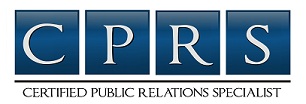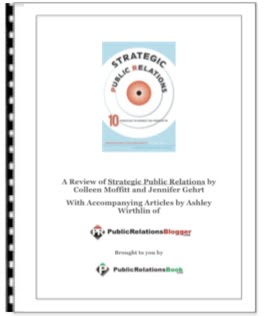________________________________________________________________________
 And in three ways vital to you as a business, non-profit or association manager.
And in three ways vital to you as a business, non-profit or association manager.
To succeed, your public relations effort needs to do something really positive about the behaviors of those outside audiences that most affect your operation.
It needs to deliver external stakeholder behavior change - the kind that leads directly to achieving your managerial objectives.
And it needs to do so by persuading those important outside folks to your way of thinking, then move them to take actions that help your department, division or subsidiary succeed.
All three, hopefully long before anybody worries about theater tickets or radio plugs!
But how do you get to the point where all three of those dynamics actually contribute to your success as a manager?
I believe the fundamental premise of public relations is a good place to start, herewith: people act on their own perception of the facts before them, which leads to predictable behaviors about which something can be done. When we create, change or reinforce that opinion by reaching, persuading and moving-to-desired-action the very people whose behaviors affect the organization the most, the public relations mission is accomplished.
Get organized around that premise and you could get behavior changes like more membership applications; customers making repeat purchases; new proposals for strategic alliances and joint ventures; community leaders beginning to seek you out; welcome bounces in show room visits; prospects starting to sniff around; capital givers or specifying sources beginning to think about you, and even politicians and lawmakers who view you as a key member of the business, non-profit or association communities.
May sound painfully obvious, but you need the entire PR team assigned to your unit on board for this ride. They need to accept that fundamental premise of public relations.
A not so obvious first step? Make certain the whole team agrees - really agrees -- why it’s so important to know how your outside audiences perceive your operations, products or services. Be deep-down-sure they accept the reality that perceptions almost always lead to destructive behaviors that can damage your unit.
Carefully go over just how you plan to monitor and gather perceptions by questioning members of your most important outside audiences. Questions like these: how much do you know about our organization? Have you had prior contact with us and were you pleased with the interchange? How much do you know about our services or products and employees? Have you experienced problems with our people or procedures?
Your PR people can be of real use for this opinion monitoring project since they already labor in the perception and behavior vineyard. Yes, you can always bring in a professional survey firm, but that can be hard on the wallet. Whether it’s your people or a survey firm who asks the questions, the objective stands: identify untruths, false assumptions, unfounded rumors, inaccuracies, misconceptions and any other potentially hurtful perception and prepare to deal with it.
Then you must carefully select which of the above becomes your top priority, yet corrective public relations goal - is it the need to clarify that misconception, or spike that rumor or correct the false assumption or inaccuracy? ! Success is just around the corner when you pick the right strategy from the three choices available to you. Change existing perception, create perception where there may be none, or reinforce it. And be certain your new strategy is a good fit with your new public relations goal.
So, just what will you say when you have the opportunity to address your key stakeholder audience? In other words, what will you say to help persuade them to your way of thinking?
Your best writer must be tasked with preparing such a message because you’ll obviously need some very special, corrective language. Not only compelling, persuasive and believable, but clear and factual if the language is to shift perception/opinion towards your point of view and lead to the planned behaviors.
At this point, you select communications tactics to carry your message to the attention of your target audience. But carefully insuring that the tactics you select have a record of reaching folks like your audience members. Fortunately, there are dozens that are available. From speeches, facility tours, emails and brochures to consumer briefings, media interviews, newsletters, personal meetings and many others.
As the credibility of your message is always at stake, you may wish to deliver it in small meetings or presentations rather than through higher-visibility media announcements.
In due course, you’ll f eel pressure for indications of progress. Which translates into another perception monitoring session with members of your key target audience. Using some of the same questions used in the original benchmark session, you will now be especially alert for signs that the questionable perception is being altered in your direction.
Here, you’re in luck because matters can always be expedited by adding more communications tactics, AND increasing their frequencies.
Thus, what should come first in any manager’s public relations effort is prompt and effective action in dealing with key, target audience perceptions by doing what is necessary to reach and move those key external audiences to actions you desire.
In the proverbial nutshell, use an action plan that helps you influence your most important outside stakeholders to your way of thinking, then move them to behave in a way that leads to the success of your department, division or subsidiary.
About The Author
Bob Kelly counsels, writes and speaks to business, non-profit and association managers about using the fundamental premise of public relations to achieve their operating objectives. He has been DPR, Pepsi-Cola Co.; AGM-PR, Texaco Inc.; VP-PR, Olin Corp.; VP-PR, Newport News Shipbuilding & Drydock Co.; director of communications, U.S. Department of the Interior, and deputy assistant press secretary, The White House. He holds a bachelor of science degree from Columbia University, major in public relations.
Article Source.
Tags: functions of public relations, public relations, PR
Public Relations Functions Involve More Than Just Plugs
________________________________________
 And in three ways vital to you as a business, non-profit or association manager.
And in three ways vital to you as a business, non-profit or association manager.To succeed, your public relations effort needs to do something really positive about the behaviors of those outside audiences that most affect your operation.
It needs to deliver external stakeholder behavior change - the kind that leads directly to achieving your managerial objectives.
And it needs to do so by persuading those important outside folks to your way of thinking, then move them to take actions that help your department, division or subsidiary succeed.
All three, hopefully long before anybody worries about theater tickets or radio plugs!
But how do you get to the point where all three of those dynamics actually contribute to your success as a manager?
I believe the fundamental premise of public relations is a good place to start, herewith: people act on their own perception of the facts before them, which leads to predictable behaviors about which something can be done. When we create, change or reinforce that opinion by reaching, persuading and moving-to-desired-action the very people whose behaviors affect the organization the most, the public relations mission is accomplished.
Get organized around that premise and you could get behavior changes like more membership applications; customers making repeat purchases; new proposals for strategic alliances and joint ventures; community leaders beginning to seek you out; welcome bounces in show room visits; prospects starting to sniff around; capital givers or specifying sources beginning to think about you, and even politicians and lawmakers who view you as a key member of the business, non-profit or association communities.
May sound painfully obvious, but you need the entire PR team assigned to your unit on board for this ride. They need to accept that fundamental premise of public relations.
A not so obvious first step? Make certain the whole team agrees - really agrees -- why it’s so important to know how your outside audiences perceive your operations, products or services. Be deep-down-sure they accept the reality that perceptions almost always lead to destructive behaviors that can damage your unit.
Carefully go over just how you plan to monitor and gather perceptions by questioning members of your most important outside audiences. Questions like these: how much do you know about our organization? Have you had prior contact with us and were you pleased with the interchange? How much do you know about our services or products and employees? Have you experienced problems with our people or procedures?
Your PR people can be of real use for this opinion monitoring project since they already labor in the perception and behavior vineyard. Yes, you can always bring in a professional survey firm, but that can be hard on the wallet. Whether it’s your people or a survey firm who asks the questions, the objective stands: identify untruths, false assumptions, unfounded rumors, inaccuracies, misconceptions and any other potentially hurtful perception and prepare to deal with it.
Then you must carefully select which of the above becomes your top priority, yet corrective public relations goal - is it the need to clarify that misconception, or spike that rumor or correct the false assumption or inaccuracy? ! Success is just around the corner when you pick the right strategy from the three choices available to you. Change existing perception, create perception where there may be none, or reinforce it. And be certain your new strategy is a good fit with your new public relations goal.
So, just what will you say when you have the opportunity to address your key stakeholder audience? In other words, what will you say to help persuade them to your way of thinking?
Your best writer must be tasked with preparing such a message because you’ll obviously need some very special, corrective language. Not only compelling, persuasive and believable, but clear and factual if the language is to shift perception/opinion towards your point of view and lead to the planned behaviors.
At this point, you select communications tactics to carry your message to the attention of your target audience. But carefully insuring that the tactics you select have a record of reaching folks like your audience members. Fortunately, there are dozens that are available. From speeches, facility tours, emails and brochures to consumer briefings, media interviews, newsletters, personal meetings and many others.
As the credibility of your message is always at stake, you may wish to deliver it in small meetings or presentations rather than through higher-visibility media announcements.
In due course, you’ll f eel pressure for indications of progress. Which translates into another perception monitoring session with members of your key target audience. Using some of the same questions used in the original benchmark session, you will now be especially alert for signs that the questionable perception is being altered in your direction.
Here, you’re in luck because matters can always be expedited by adding more communications tactics, AND increasing their frequencies.
Thus, what should come first in any manager’s public relations effort is prompt and effective action in dealing with key, target audience perceptions by doing what is necessary to reach and move those key external audiences to actions you desire.
In the proverbial nutshell, use an action plan that helps you influence your most important outside stakeholders to your way of thinking, then move them to behave in a way that leads to the success of your department, division or subsidiary.
About The Author
Bob Kelly counsels, writes and speaks to business, non-profit and association managers about using the fundamental premise of public relations to achieve their operating objectives. He has been DPR, Pepsi-Cola Co.; AGM-PR, Texaco Inc.; VP-PR, Olin Corp.; VP-PR, Newport News Shipbuilding & Drydock Co.; director of communications, U.S. Department of the Interior, and deputy assistant press secretary, The White House. He holds a bachelor of science degree from Columbia University, major in public relations.
Article Source.
Tags: functions of public relations, public relations, PR
Popular choices
Subscribe to:
Post Comments (Atom)






Comments (0)
Post a Comment